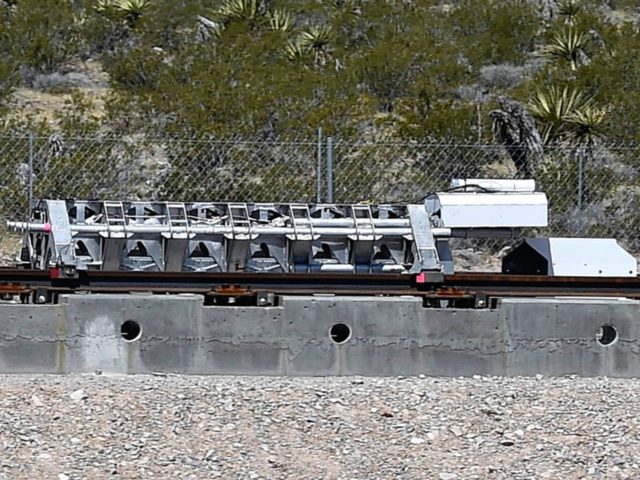“Hyperloop One,” which promises to rocket commuters at up to 700 miles-per-hour in what looks like a pneumatic tube, successfully demonstrated a vehicle at a Nevada test site and announced $80 million in new funding from partnerships and venture capital.
At a secluded test site about 10 miles from Las Vegas, the Hyperloop One conducted a Propulsion Open Air Test using electromagnets and compressed air forced through runners to create a levitated and near-frictionless surface to propel the company’s “Sandshark” test sled around a specially-built 1500 ft. test track at 115 mph.
Following a 10-second countdown, the Sandshark vehicle instantly accelerated along rails in a straight line until it slammed into its sand barrier, which looked like a brownish-red explosion as the test-sled ground to a halt.
According to Hyperloop One co-founder Brogan BamBrogan, the test served as tangible evidence for potential partners that the disruptive start-up has achieved enough “proof of concept” to scale up to a the full-scale prototype capsule demonstration by the end of the year.
Human travel on a Hyperloop has been described as experiencing the 2.5 g-force acceleration of a high speed elevator, followed by a smooth ride without turbulence or sharp curves.
Hyperloop One executives have stated that the system will be ideal for a wide range of high-speed on-demand travel and freight transport applications, including intercity movement, intracity commuting and container freight management.
To make Hyperloop One operational in 5 years, the company plans to develop the “ecosystem” for commuter and regional transportations, then to let other companies, individuals, and governments adapt the concept to their operational needs.
That strategy allowed Hyperloop One to gain financing from a combination of venture capital firms, along with transportation operators and engineering companies.
The company announced the closing of secondary financing of $80 million from investors including France’s state-owned national rail company SNCF, Caspian Venture Partners, 8VC, GE Ventures, Khosla Ventures, Sherpa Ventures, ZhenFund and 137 Ventures.
The Hyperloop One propulsion system for the test consisted of a sled-mounted rotor and a 187-ft long “stator.” The Sandshark is supposedly rated to be capable of achieving a top speed of 400 mph in two seconds.
But the real challenge, according to gizmag.com, is to develop the Variable Frequency Devices, software, and switching gear to make the propulsion system scalable over distance and economic on a cost-per-mile basis.
Co-founder and Executive Chairman Shervin Pishevar stated in a press release, “The overwhelming response we’ve had already confirms what we’ve always known, that Hyperloop One is at the forefront of a movement to solve one of the planet’s most pressing problems.” He added, “The brightest minds are coming together at the right time to eliminate the distances and borders that separate economies and cultures.”

COMMENTS
Please let us know if you're having issues with commenting.